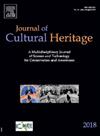Uncovering a lost narrative: Rediscovering Paulus Potter's Head of a White Bull through multidisciplinary analysis
IF 3.3
2区 综合性期刊
0 ARCHAEOLOGY
引用次数: 0
Abstract
Head of a White Bull, a fragmentary painting attributed to Paulus Potter (1625–1654), has been identified as part of a lost composition depicting The Abduction of Europa. Multidisciplinary analysis, including infrared reflectography (IRR), reflectance imaging spectroscopy in the shortwave infrared range (RIS-SWIR), handheld and macro X-ray fluorescence (XRF) scanning, Fourier transform infrared spectroscopy (FTIR), Raman microscopy, and scanning electron microscopy with energy dispersive X-ray spectroscopy (SEM-EDS), revealed hidden details such as the figure of Europa and provided insights into the painting’s material history. The study uncovered compositional differences between the original and overpaint layers. Differences in the composition of the original smalt, a cobalt-containing blue pigment, suggest variations in pigment sources or processing methods. The overpaint, applied to conceal Europa’s figure, was found to contain a mixture of Prussian blue and Naples yellow, indicative of later interventions. The condition of these original areas is of a very high standard, further affirming the remarkable preservation of the underlying composition. These findings not only reconstruct the lost narrative but also raise important questions about the ethical presentation of fragmentary works, challenging traditional notions of completeness and artistic intent. This research highlights the value of interdisciplinary approaches in art historical and conservation studies, offering new perspectives on the evolution of paintings over time.
揭示失落的叙事:通过多学科分析重新发现保卢斯·波特的《白牛头》
《白牛的头》是保卢斯·波特(1625-1654)的一幅残片画,现已被确认为一幅丢失的描绘欧罗巴被绑架的作品的一部分。多学科分析,包括红外反射(IRR),短波红外范围内的反射成像光谱(RIS-SWIR),手持式和宏x射线荧光(XRF)扫描,傅里叶变换红外光谱(FTIR),拉曼显微镜和扫描电子显微镜与能量色散x射线光谱(SEM-EDS),揭示了隐藏的细节,如木卫二的人物,并提供了对绘画材料历史的见解。这项研究揭示了原始和复涂层之间的成分差异。原始的小钴蓝色颜料成分的差异,表明颜料来源或加工方法的差异。这幅用于掩盖欧罗巴形象的复漆被发现含有普鲁士蓝和那不勒斯黄的混合物,表明了后来的干预。这些原始区域的条件是非常高的标准,进一步肯定了对底层成分的卓越保存。这些发现不仅重建了失落的叙事,而且提出了关于碎片作品的伦理呈现的重要问题,挑战了传统的完整性和艺术意图观念。这项研究突出了跨学科方法在艺术史和保护研究中的价值,为绘画随时间的演变提供了新的视角。
本文章由计算机程序翻译,如有差异,请以英文原文为准。
求助全文
约1分钟内获得全文
求助全文
来源期刊

Journal of Cultural Heritage
综合性期刊-材料科学:综合
CiteScore
6.80
自引率
9.70%
发文量
166
审稿时长
52 days
期刊介绍:
The Journal of Cultural Heritage publishes original papers which comprise previously unpublished data and present innovative methods concerning all aspects of science and technology of cultural heritage as well as interpretation and theoretical issues related to preservation.
 求助内容:
求助内容: 应助结果提醒方式:
应助结果提醒方式:


